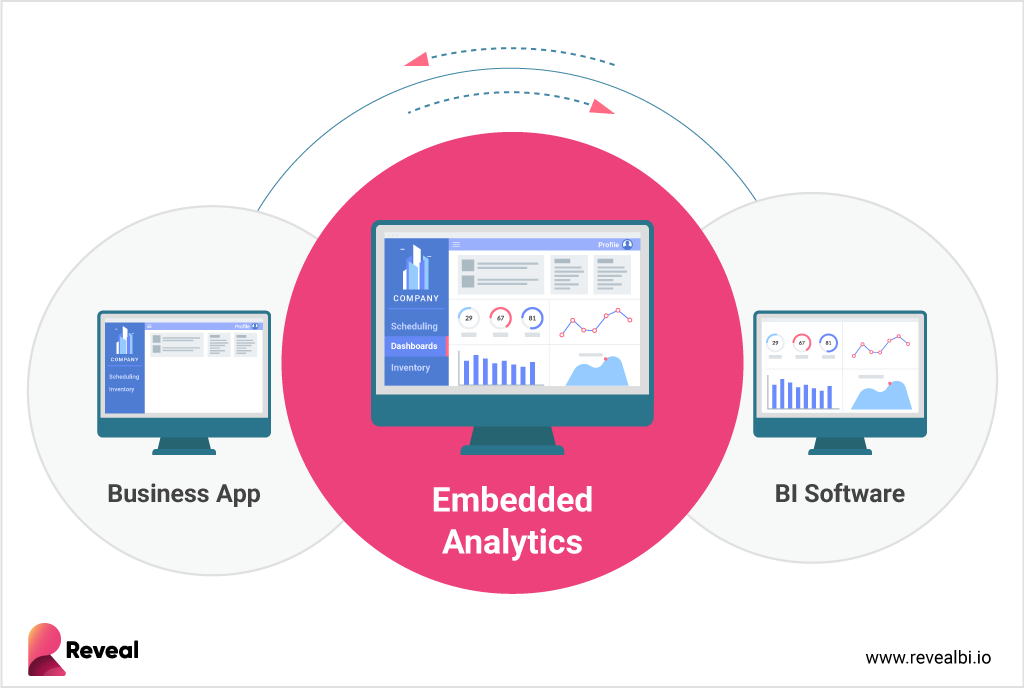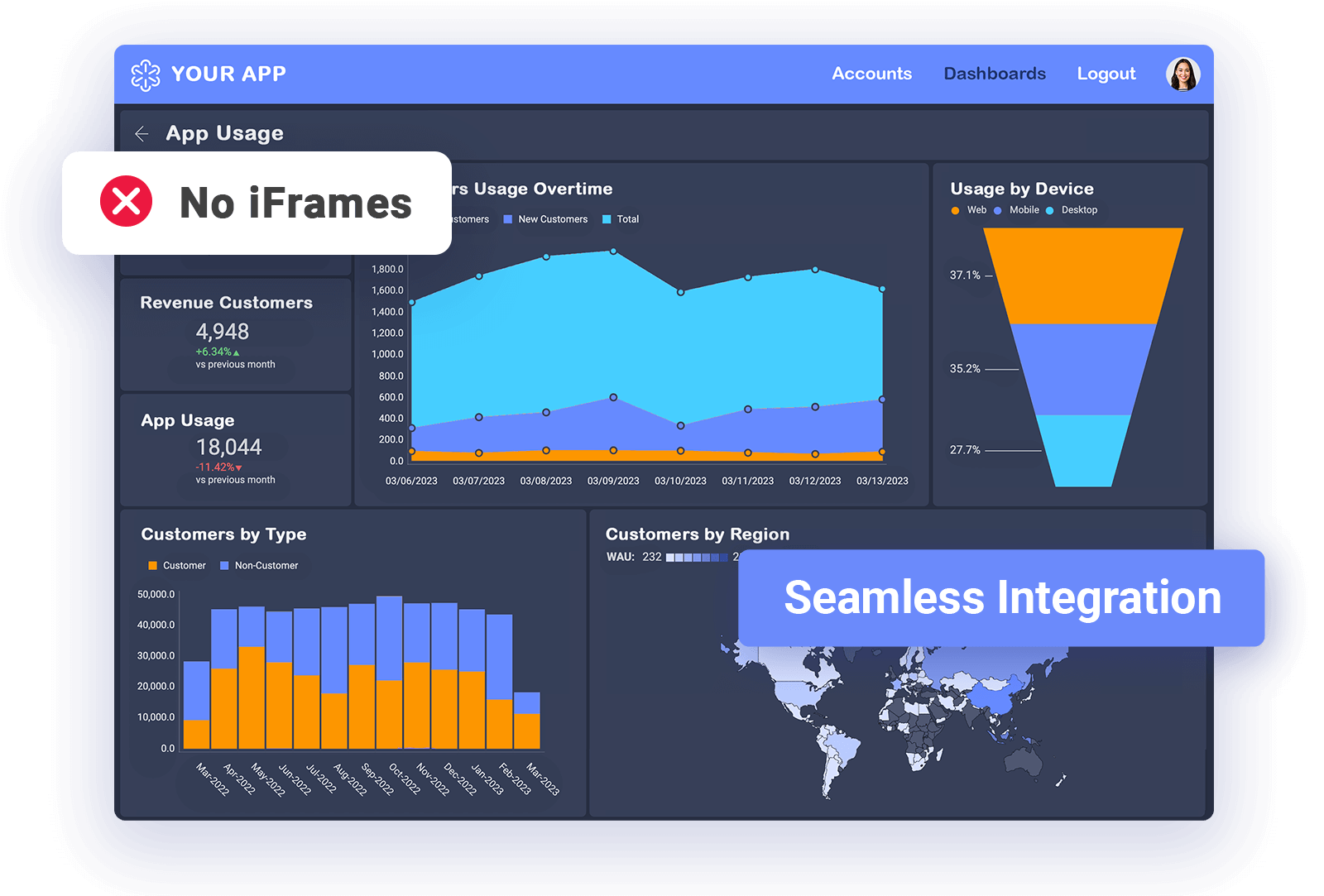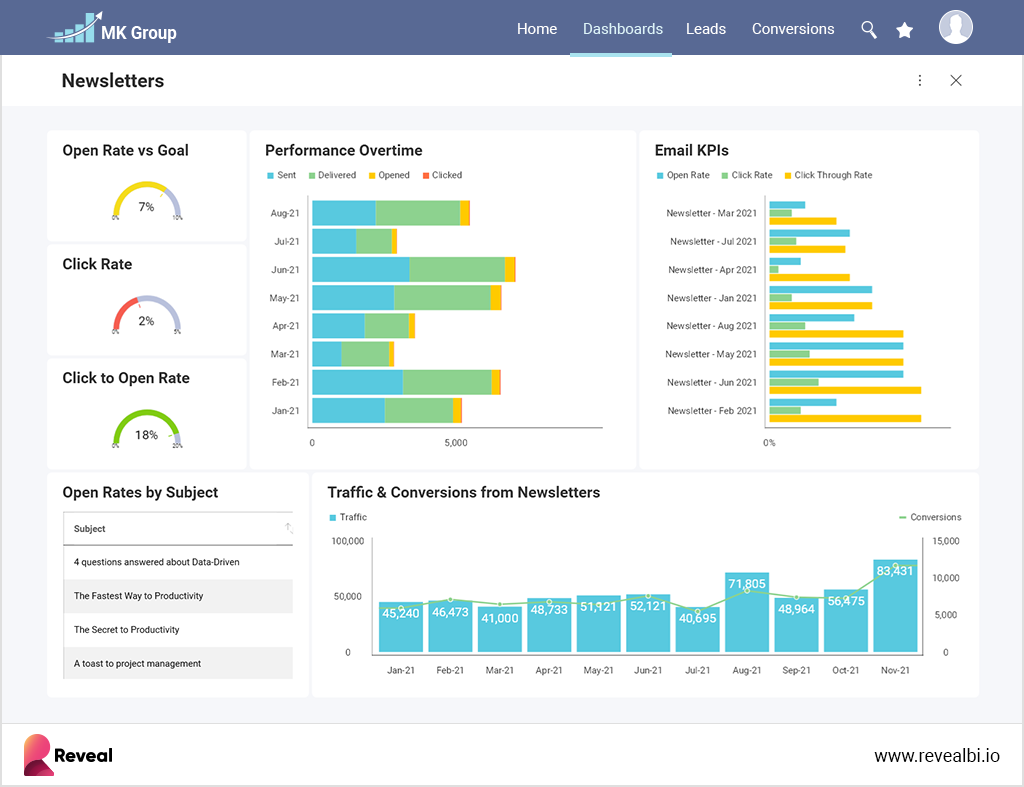
The Missing Piece in Enterprise BI: Intuitive, Embedded, and Self-Service Analytics
Most enterprise BI platforms were built for internal reporting, not for modern SaaS products utilizing customer-facing analytics. They sit outside your application, fragment your UX, and delay decision-making. Modern enterprise software requires analytics that are intuitive, embedded, and self-service by design. Reveal was built to deliver exactly that—with no iFrames, no handoffs, and no compromises.
Executive Summary:
Key Takeaways:
- test
- test
- test
Your engineering team is shipping fast. Your UX is evolving. Your roadmap is packed with features designed to meet rising customer expectations. But your enterprise BI setup? It’s often still stuck in a silo, delivered through disconnected tools, legacy portals, or time-consuming handoffs.
This disconnect isn’t just a UX issue. It slows down decision-making, breaks user flow, and limits how much value customers get from your product.
Most enterprise business intelligence platforms were never designed for in-app use. They were built for analysts, not developers or product teams. Users are forced to leave your software to access insights, adding friction when insights should be immediate.
Embedding analytics isn’t an enhancement. It’s a core part of modern product strategy. When done right, it increases adoption, accelerates decision-making, and directly supports data monetization and retention goals.
Reveal addresses this gap by transforming analytics into a seamless, fully embedded experience. It blends into your app, scales with your architecture, and reflects your brand without adding overhead.
Key Takeaways
- Legacy BI tools weren’t built for modern, in-product experiences—they live outside the workflow, creating friction, slowing decisions, and limiting user engagement.
- Embedded analytics is no longer a nice-to-have—it’s a strategic product capability that drives adoption, retention, and long-term value.
- iFrames and disconnected portals are outdated—they signal technical debt and block innovation. Native SDK-based integration is now the standard.
- Self-service analytics empowers users and relieves dev teams—freeing product and engineering to focus on core features instead of managing reports.
- Reveal transforms BI from a separate system into a product-native experience—with full control over branding, UX, and data delivery at scale.
Why Legacy BI Fails Inside Modern Products?
Enterprise BI was historically designed for high-scale, centralized reporting. Think dashboards built by analysts, delivered through scheduled reports, and governed tightly by IT. That model worked for internal operations, but it breaks down when applied to modern SaaS or ISV environments.
Today, enterprise business intelligence must serve dual audiences:
- Internal users who need secure, governed reporting
- Customers who expect embedded, contextual insight right where they work
Legacy BI tools weren’t built for this. Most can’t deliver the UI control, flexibility, or in-product experience that modern applications require. Instead, they rely on iFrames, external portals, and analyst intervention, none of which scale or meet user expectations for speed and ease of use.
This is where CTOs and product leaders need to shift their mindset—from supporting BI as a back-office function to delivering it as a native product capability.

There are two primary solutions to your analytics problem: an in-house analytics tool or a purpose-built embedded analytics platform. If you’re still deciding whether to build analytics in-house or embed a modern solution, this breakdown of when to buy or build your analytics platform can help guide your decision.
Traditional tools may still check the BI box, but they don’t help your product stand out. They add overhead instead of value, slow your roadmap, and keep insight out of reach for the users who need it most.
Embedded BI as a Strategic Product Decision
Modern enterprise BI is more than reporting. It’s infrastructure for delivering insight as a feature of your product.
The shift to embedded analytics is becoming a key part of how software teams increase feature adoption, accelerate roadmap delivery, and open new revenue opportunities. Modern embedded analytics bridges the gap between traditional reporting systems and real-time, in-app insight that users actually act on.
This approach gives product and engineering teams a way to:
- Differentiate their UX with built-in dashboards
- Launch data features without tying up backend resources
- Reduce reliance on analyst-created reports
- Support monetization models based on advanced analytics
But success here depends on going beyond basic dashboard embedding. The solution must look, feel, and perform like a native part of the application, with control over the interface, logic, and performance.
Reveal is the perfect example of such a solution. With a developer-first SDK, robust APIs, and full white-label support, it delivers enterprise business intelligence that integrates directly into your app without bloated infrastructure or per-user licensing limits.
What Embedded Analytics Must Deliver in 2025
To keep pace with evolving products and rising user expectations, embedded enterprise BI must meet a higher bar—on usability, integration, and control.
1. Intuitive
Insight should not require training. Drag-and-drop dashboards, contextual filtering, and guided drilldowns must feel as smooth and familiar as any other part of your UI. Users should be able to explore data on their own terms without relying on IT or analysts.
2. True Embedded
iFrames are a workaround. A real solution gives you direct control over how analytics is rendered, styled, and behaves inside your application. It’s the difference between a third-party add-on and a first-class product feature. White-label analytics ensures that dashboards don’t look external or disconnected. Instead, they match your product’s branding, layout, and interaction model.
3. Self-Service
Product teams should not be the reporting department. Your users need to create, customize, and act on data independently, which reduces support overhead and improves engagement. That’s only sustainable if performance holds under real workloads.

Scriptly integrated Reveal to give pharmacies real-time, self-service access to key prescription and trend data. Instead of submitting data requests or waiting for pre-built reports, users can now build dashboards directly within the Scriptly platform, enabling faster decisions at the pharmacy level without pulling dev teams into the loop.
Scalability matters here, too. In Scriptly’s case, giving pharmacy users real-time access to custom dashboards meant connecting to multiple data systems behind the scenes without compromising performance.
So, CTOs should ensure the embedded analytics solution they choose supports a broad range of data sources, so even self-service users working across cloud and on-prem environments get fast, reliable insights every time.
Business and Technical Impact for CTOs
Adopting embedded enterprise BI as a product capability unlocks measurable advantages across multiple dimensions:
Faster decision-making
Users act with confidence when data is embedded into workflows. No need to toggle to a different tool or wait on centralized reporting. The insight is right where they need it when they need it.
Increased feature adoption
Integrated dashboards feel like part of the core experience, not an afterthought. Unlike legacy enterprise BI tools that sit in portals and often go untouched, in-product dashboards increase engagement and long-term retention
Improved retention and upsell
Products using embedded enterprise BI software are better equipped to drive value-based pricing, premium feature adoption, and stronger customer satisfaction.
Reduced support overhead
With self-service access to reporting, users no longer flood dev or analyst teams with ad hoc requests. This shift is especially valuable in smaller teams managing high user volumes or complex data pipelines.
Streamlined architecture
A true embedded solution means fewer dependencies, more control, and clean code integration.
True embedded enterprise BI solutions use SDKs and APIs to integrate cleanly into your product. No legacy dependencies. No external portals. Just full control, faster iteration, and simplified deployment.
Compared to traditional enterprise business intelligence tools, embedded platforms shift analytics from being a siloed department resource to a native product advantage. That repositioning changes how you compete and how your team scales.
What to Look for in an Embedded BI Platform

If you’re modernizing your product’s analytics, focus on the technical foundation, not just the feature list.
- Embedded SDKs: Avoid iFrames. Look for native SDKs that let you embed analytics directly into your codebase, with full control over UX, logic, and component behavior.
- White-label control: Your product, your branding. Fonts, layouts, and interactions should reflect your design system, not the vendor’s. Users should never feel like they’ve left your app.
- API extensibility: Rich client/server APIs make it easier to handle permissions, manage behavior, pass filters, and trigger custom actions based on user input.
- Real-time performance: Speed matters. Data must be fresh, and dashboards must respond fast across hybrid environments and varied usage scenarios.
- Scalable licensing: Avoid pricing models that penalize growth. Choose a solution with transparent, predictable costs—especially if you’re embedding it into a product with its own usage tiers.
- Advanced capabilities: Forecasting, natural language interaction, and AI-powered analytics shouldn’t require separate tools or extra contracts. These features should be available out of the box and flexible enough to fit your product’s roadmap.
Going through all these features with multiple embedded BI tools can be overwhelming. This Embedded BI features checklist will help you separate surface-level embedding from real integration.
Reveal: Built for Product-First Analytics
If your product already delivers value, embedded analytics is how you multiply it.
We’ve seen how legacy enterprise BI tools fall short inside modern applications. They create friction, delay insight, and don’t scale with how teams build or how users think. Embedding analytics directly into your product intuitively, securely, and without developer overhead is now the baseline, ensuring better retention, new monetization opportunities, and unobstructed growth.

That shift has technical implications, too. Your analytics layer has to be performant, self-service, brand-consistent, and future-ready. Evaluating platforms means looking past surface-level integrations and toward architectural control, extensibility, and a licensing model that fits how you scale.
Reveal bridges the gap between traditional BI and modern product design. It’s purpose-built for software teams that need analytics to live inside the application, with full white-label control, developer-first tooling, and pricing that supports scale.
No iFrames. No bolt-ons. No vendor traps.
Reveal makes BI a first-class feature of your product—one that drives adoption, delivers insight, and keeps your roadmap aligned with user expectations.


 Return to Blog
Return to Blog


